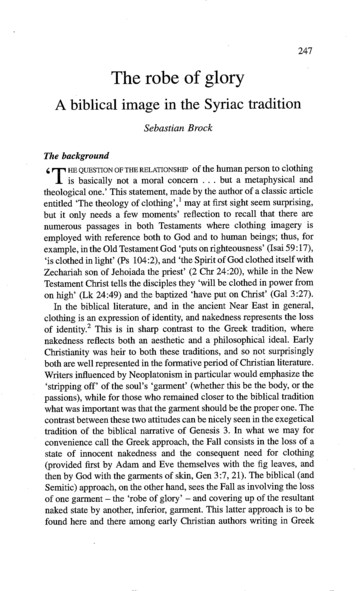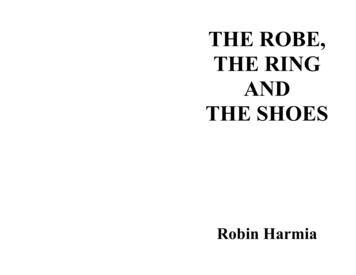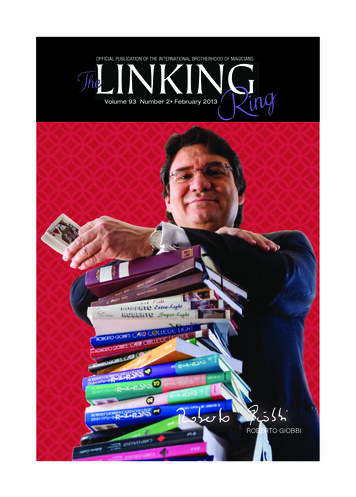
Transcription
247The robe of gloryA biblical image in the Syriac traditionSebastian BrockThe background6 V ' HE QUESTIONOF THE RELATIONSHIP of the human person to clothing. t is basically not a moral concern . . . but a metaphysical andtheological one.' This statement, made by the author of a classic articleentitled 'The theology of clothing', 1 may at first sight seem surprising,but it only needs a few moments' reflection to recall that there arenumerous passages in both Testaments where clothing imagery isemployed with reference both to God and to human beings; thus, forexample, in the Old Testament God 'puts on righteousness' (Isai 59:17),'is clothed in light' (Ps 104:2), and 'the Spirit of God clothed itself withZechariah son of Jehoiada the priest' (2 Chr 24:20), while in the NewTestament Christ tells the disciples they 'will be clothed in power fromon high' (Lk 24:49) and the baptized 'have put on Christ' (Gal 3:27).In the biblical literature, and in the ancient Near East in general,clothing is an expression of identity, and nakedness represents the lossof identity, z This is in sharp contrast to the Greek tradition, wherenakedness reflects both an aesthetic and a philosophical ideal. EarlyChristianity was heir to both these traditions, and so not surprisinglyboth are well represented in the formative period of Christian literature.Writers influenced by Neoplatonism in particular would emphasize the'stripping off' of the soul's 'garment' (whether this be the body, or thepassions), while for those who remained closer to the biblical traditionwhat was important was that the garment should be the proper one. Thecontrast between these two attitudes can be nicely seen in the exegeticaltradition of the biblical narrative of Genesis 3. In what we may forconvenience call the Greek approach, the Fall consists in the toss of astate of innocent nakedness and the consequent need for clothing(provided first by Adam and Eve themselves with the fig leaves, andthen by God with the garments of skin, Gen 3:7, 21). The biblical (andSemitic) approach, on the other hand, sees the Fall as involving the lossof one garment - the 'robe of glory' - and covering up of the resultantnaked state by another, inferior, garment. This latter approach is to befound here and there among early Christian authors writing in Greek
248THEROBEOF G L O R Yand Latin, but it is best witnessed in Syriac literature where we find ahighly imaginative use of clothing imagery in the context of theology)Indeed, as we shall see, the entire course of salvation history came to bedescribed in terms of taking off and putting on clothing, starting andending with the 'robe of glory'.That there was to be a final 'garment of glory' in which the righteouswould be clothed was probably a fairly widespread idea by the time ofChrist, and it appears most prominently in different parts of theEthiopic book of Enoch, in particular at 62:15-16, 'the righteous andelect will have risen from the e a r t h . . , and will be clothed with garments of glory'. In the Syriac translation of Daniel it is interesting tofind that Daniel's angelic interlocutor is described as wearing 'garmentsof glory' (10:5, 12:7); in the Hebrew he is just clothed in linen).The exegetical roots of the traditionIn the Hebrew text of Genesis 3 there is of course no mention of any'robe of glory' worn by Adam and Eve prior to the Fall, but in an earlyexegetical tradition, to which later Jewish midrashim and SyriacChristian writers were heirs, the verb in Genesis 3:21 was taken as apluperfect, 'God had . . . clothed them', thus referring, not to theclothing of Adam and Eve after the Fall (as it appears in all moderntranslations), but to their original clothing, prior to the Fall.Furthermore, this clothing was understood as being not of 'skin'(Hebrew 'or) but of light ('or), or of glory (a translation reflected in partof the Targum tradition). It may be that this tradition was alreadyfamiliar to the Syriac translator of psalm 8, for in verse 6, where theHebrew (together with Septuagint, Targum and Vulgate) has 'You madehim a little less than the angels, in honour and glory did you crownhim', the Syriac has altered this to ' . . . in honour and glory did youclothe him'.Given this tradition of both a primordial and an eschatological 'robeof glory' (often also described as one 'of light'), Syriac writers imaginatively drew on this theme of the 'robe of glory' to illustrate thedifferent stages in the course of the entire span of salvation history.Since they rarely describe the entire scenario from start to finish, butprefer to allude to particular episodes while presupposing an awarenessof the whole, it will be helpful to have in mind from the start the mainstages of this drama of salvation, reduced to a schematic outline:-in their initial state in Paradise Adam and Eve are clothed in the robeof glory;
THEROBEOFGLORY249their disobedience of God's commandment not to eat of the Tree ofKnowledge results in their loss of the robe of glory;a prime aim henceforth of divine providence is to provide humanbeings with a means by which they can recover the lost robe of glory.At the incarnation the divine Word thus 'puts on a human body', andat his baptism he makes the robe of glory available once again tohumanity by depositing it in the river Jordan (seen as one of thefountainheads of Christian baptism, along with John 19:34);- at Christian baptism the baptized put on, in potential, the robe ofglory (i.e. when, in Pauline terms, 'they put on Christ');- at the eschaton the robe of glory will be theirs in reality, providedthey have preserved it unsullied during their lifetime. As willemerge, this final stage is not just seen as a return to the primordialParadise, for the eschatological Paradise is far more glorious.--How do Syriac writers describe the course of this drama? In providing an answer, use will be made in particular of the writings of thegreat fourth-century theologian-poet St Ephrem and of the liturgicaltexts of the various Syriac Churches.The primordial robe of glory and its lossAdam and Eve are understood both as individuals and as representinghumanity in general; Adam is thus Everyman, and indeed sometimesnot just every man, but every human being. The Genesis narrative isunderstood as having paradigmatic significance, providing an explanation for the state of flawed humanity in which we find ourselves. At thesame time, by describing what was, the Genesis narrative hints at whatmight be.Although the Syriac translation of Genesis 3:21, following thestandard Hebrew text, has 'garments of skin' as the clothing providedby God after the Fall, Ephrem and other Syriac writers were also wellaware of the tradition of Adam and Eve being clothed in a 'robe ofglory' prior to the Fall, despite the fact that they no longer had anyawareness of the exegetical origin of this in Genesis 3:21. Thus,commenting on Genesis 2:25, Ephrem writes, reflecting the characteristically Semitic dislike of nakedness :4It says 'The two of them were naked, but they were not ashamed'. Itwas not because they were ignorant of what shame was that they werenot ashamed . . . It was because of the glory in which they werewrapped that they were not ashamed. Once this had been taken away
250THEROBEOF GLORYfrom them, after the transgression of the commandment, they wereashamed because they had been stripped of it, and the two of themrushed to the leaves in order to cover not so much their bodies as theirshameful members.Yet, even though they had this raiment of glory, Ephrem goes on toexplain that Adam and Eve were nonetheless created in an intermediatest ate: 5Because God had given to Adam everything inside and outsideParadise through Grace, requiring nothing in return, either for hiscreation or for the glory in which He had clothed him, nevertheless outof Justice God held back one tree from h i m . . . For when God createdAdam, He did not make him mortal, nor did He fashion him immortal;this was so that Adam himself, either through keeping this commandment, or by transgressing it, might acquire from this single tree theoutcome he chose of his own free w i l l . . . Even though God had givenAdam and Eve everything else out of Grace, He wished to confer onthem, out of Justice, the immortal life which is granted through theeating of the Tree of Life.Allusions to this scenario are to be found frequently in the liturgicalpoetry of the Syriac Churches. Here a single example, from theMaronite Morning Office for Fridays, must suffice:At the beginning, before he sinned, Adam had been clothed withradiance and g l o r y . . .'Do not eat of the tree, otherwise you will taste death and be stripped ofyour g l o r y . . .you will be stripped of that light and glory that I clothed you in if youeat of it.'The divine c o m m a n d m e n t not to eat of the Tree of Knowledge was thusgiven in order to allow Adam and Eve the opportunity to exercise theirfree will. Had they obeyed this 'tiny commandment' (as Ephrem put it)they would have been rewarded by being given access to the Tree ofLife. As it was, o f course, not only did they not gain access to the fruitof the Tree of Life, but they fell into the state of mortality as well.The exchange of garmentsHow does divine providence set out to remedy this situation withoutimpinging in any way on the initial gift to humanity of free will?
THEROBEOF G L O R Y251Having first of all made himself known to humanity by 'putting onnames', allowing himself to be spoken of in human language in the OldTestament, God then sends his Son who 'put on a human body' at theincarnation, the purpose being to provide a means of reclothinghumanity in the lost robe of glory: 6God's Majesty that had clothed Itself in all sorts of similitudessaw that humanity did not want to find salvation through thisassistance,so He sent His Beloved One who, instead of the borrowed similitudewith which God's Majesty had previously clothed Itself,clothed Himself with real limbs, as the First-Born,and was mingled with humanity:He gave what belonged to Him and took what belonged to usso that this intermingling of His might give life to our dead state.More frequently Ephrem simply uses the phrase 'he put on a body' todescribe the incarnation. This phrase was already in regular use by histime among Syriac writers, and in the earliest Syriac translation of theNicene Creed it is employed to render the Greek esarkOth , 'he becameincarnate'. Syriac writers in fact employ a whole variety of differentterms in connection with the metaphor: thus at the incarnation thedivine Word is described as having put on 'the body of Adam', 'Adam','the body of mortal Adam', 'the first human', 'a body from the seed ofAdam', 'humanity', 'our humanity', 'our nature', and even 'us'.Such phrases are frequently to be encountered in the liturgical textsof all the Syriac Churches; the following example is from the prayerfollowing the Sanctus in the oldest of all Christian eucharistic liturgiesstill in use, the Anaphora of the Apostles Addai and Mari of the Churchof the East, with a parallel text preserved in the Maronite Anaphora ofSt Peter (often known as the 'Sharrar', from its opening word):We, Your sinful servants, give thanks to You, for You have caused Yourgrace to work in us in a way that cannot be repaid, in that You have puton our humanity in order to give us life by Your divinity.Christ's human body may sometimes be described as 'the garmentwhich He borrowed from us to cover Himself',7 introducing the idea ofan exchange of garments which is already brought out by Ephrem inone of his hymns on the Nativity where he writes 'His mother, whosebody He had put on, put on His glory'.S Elsewhere in the same hymn
252THEROBEOFGLORYcycle Ephrem speaks of Mary as having 'woven a garment and clothedHim because He had stripped off His glory' .9 More frequently theexchange of clothing is mentioned in the context of Christian baptism,taking as its basis Galatians 3:27; thus in a baptismal hymn we find 'Hehas put us on, and we have put Him on'.l Since the incarnation is seenas being effective for all time, past as well as present and future, Adamhimself can also be described as benefiting from this exchange: 11As the Lord put on Adam bodily,so too did Adam put on the Son spiritually.Christ put on Adam's body in Mary's womb.and Adam put on that choice robe of glory.Eve can equally be described as benefiting: 12The daughter gave support to her mother who had fallen,and because she had clothed herself in fig leaves of shameher daughter wove and gave to her a garment of glory.In Mary there has Come hope for the female sex:from the insults they have heard and the shame they have feltshe has given them freedom; they are no longer subject to blame.The significance of Christ's baptism in the JordanThe baptism of Christ is seen as playing a central role in the course ofsalvation history: it constitutes one of the three 'staging posts' in thecourse of his incarnate life, being one of the three 'wombs' into whichthe divine Word descended: the womb of Mary, the womb o f theJordan, and the womb of Sheol (the world of the dead). 13 These threepoints in historical time are seen as converging together in sacred time,so that Christ's baptism, alongside his death and resurrection, constitutes the fountainhead of Christian baptism. This too can be expressedin terms of the imagery of the robe of glory, as in the following passagefrom the poet Jacob of Serngh (who died in 521): 14Christ came to baptism; He went down and placed in the baptismalwaterthe robe of glory, to be there for Adam who had lost it.The same idea is frequently found in liturgical poetry for Epiphany (inthe Eastern churches, the feast of the Baptism of Christ); thus in theSyrian Orthodox tradition: 15
THEROBEOF G L O R Y253He who had no need of it was baptized in the river Jordan,leaving in it the garment of immortality for the nakedso that they might be covere
The robe of glory A biblical image in the Syriac tradition Sebastian Brock The background 6 V' HE . Yet, even though they had this raiment of glory, Ephrem goes on to explain that Adam and Eve were nonetheless created in an intermediate st ate: 5 Because God had given to Adam everything inside and outside Paradise through Grace, requiring nothing in return, either for his creation or for .











